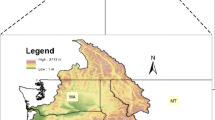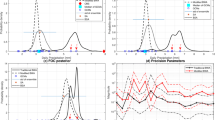Abstract
Projections of changes in extreme climate are sometimes predicted by using multi-model ensemble methods such as Bayesian model averaging (BMA) embedded with the generalized extreme value (GEV) distribution. BMA is a popular method for combining the forecasts of individual simulation models by weighted averaging and characterizing the uncertainty induced by simulating the model structure. This method is referred to as the GEV–embedded BMA. It is, however, based on a point-wise analysis of extreme events, which means it overlooks the spatial dependency between nearby grid cells. Instead of a point-wise model, a spatial extreme model such as the max-stable process (MSP) is often employed to improve precision by considering spatial dependency. We propose an approach that integrates the MSP into BMA, which is referred to as the MSP–BMA herein. The superiority of the proposed method over the GEV–embedded BMA is demonstrated by using extreme rainfall intensity data on the Korean peninsula from Coupled Model Intercomparison Project Phase 5 (CMIP5) multi-models. The reanalysis data called Asian precipitation highly-resolved observational data integration towards evaluation, v1101 and 17 CMIP5 models are examined for 10 grid boxes in Korea. In this example, the MSP–BMA achieves a variance reduction over the GEV–embedded BMA. The bias inflation by MSP–BMA over the GEV–embedded BMA is also discussed. A by-product technical advantage of the MSP–BMA is that tedious ‘regridding’ is not required before and after the analysis while it should be done for the GEV–embedded BMA.




Similar content being viewed by others
References
Arisido MW, Gaetan C, Zanchettin D et al (2017) A Bayesian hierarchical approach for spatial analysis of climate model bias in multi-model ensembles. Stoch Environ Res Risk Assess 31(10):2645–2657. https://doi.org/10.1007/s00477-017-1383-2
Beven K (2006) A manifesto for the equifinality thesis. J Hydrol 320:18–36
Buishand TA, de Haan L, Zhou C (2008) On spatial extreme: with application to a rainfall problem. Ann Appl Stat 2(2):624–642
Casey T (1995) Optimal linear combination of seasonal forecasts. Aust Meteor Mag 44:219–224
Coelho CA, Pezzulli SS, Balmaseda M et al (2004) Forecast calibration and combination: a simple Bayesian approach for ENSO. J Clim 17:1504–1516
Coles S (2001) An introduction to statistical modelling of extreme values. Springer, New York, p 224
Cooley D, Cisewski J, Erhardt RJ, Jeon S et al (2012) A survey of spatial extremes: measuring spatial dependence and modeling spatial effects. Revstat 10(1):135–165
Cressie N, Wikle C (2011) Statistics for spatio-temporal data. Wiley, Hoboken
Davison AC, Gholamrezaee MM (2012) Geostatistics of extremes. Proc R Soc A 468:581–608. https://doi.org/10.1098/rspa.2011.0412
Davison AC, Padoan SA, Ribatet M (2012) Statistical modelling of spatial extremes (with discussions). Stat Sci 27(2):161–186
de Haan L (1984) A spectral representation for max-stable processes. Ann Probab 12(4):1194–1204
Diggle PJ, Ribeiro PJ Jr (2007) Model-based geostatistics. Springer, New York
Fawcett L, Walshaw D (2016) Sea-surge and wind speed extremes: optimal estimation strategies for planners and engineers. Stoch Environ Res Risk Assess 30(2):463–480
Gaume J, Eckert N, Chambon G, Naaim M, Bel L (2013) Mapping extreme snowfalls in the French Alps using max-stable processes. Water Resour Res 49:1079–1098. https://doi.org/10.1002/wrcr.20083
Hoeting JA, Madigan D, Raftery AE, Volinsky CT (1999) Bayesian model averaging: a tutorial. Stat Sci 14(4):382–417
Hosking JRM (1990) L-moments: analysis and estimation of distributions using linear combinations of order statistics. J R Stat Soc Ser B 52:105–124
Hosking JRM, Wallis JR, Wood EF (1985) Estimation of the generalized extreme-value distribution by the method of probability weighted moments. Technometrics 27(3):251–261
Huo W, Li Z, Wang J et al (2018) Multiple hydrological models comparison and an improved Bayesian model averaging approach for ensemble prediction over semi-humid regions. Stoch Environ Res Risk Assess. https://doi.org/10.1007/s00477-018-1600-7
Kabluchko Z, Schlather M, de Haan L (2009) Stationary max-stable fields associated to negative definite functions. Ann Probab 37:2042–2065
Kharin VV, Zwiers FW, Zhang X, Wehner M (2013) Changes in temperature and precipitation extremes in the CMIP5 ensemble. Clim Change 119:345–357
Leadbetter MR, Lindgren G, Rootzen H (1983) Extremes and related properties of random sequences and processes. Springer, New York, p 336
Lee Y, Yoon S, Murshed MS, Kim MK, Cho CH, Baek HJ, Park JS (2013) Spatial modeling of the highest daily maximum temperature in Korea via max-stable processes. Adv Atmos Sci 30(6):1608–1620
Madadgar S, Moradkhani H (2014) Improved Bayesian multimodeling: integration of copulas and Bayesian model averaging. Water Resour Res 50(12):9586–9603
Mok KM, Yuen KV, Hoi KI et al (2018) Predicting ground-level ozone concentrations by adaptive Bayesian model averaging of statistical seasonal models. Stoch Environ Res Risk Assess 32(5):1283–1297. https://doi.org/10.1007/s00477-017-1473-1
Najafi MR, Moradkhani H (2015) Multi-model ensemble analysis of runoff extremes for climate change impact assessments. J Hydrol 525:352–361
Nelsen RB (2006) An introduction to copulas, 2nd edn. Springer, New York
Oesting M, Stein A (2017) Spatial modeling of drought events using max-stable processes. Stoch Environ Res Risk Assess 32:63–81. https://doi.org/10.1007/s00477-017-1406-z
Padoan SA, Ribatet M, Sisson SA (2010) Likelihood-based inference for max-stable processes. J Am Stat Assoc 105:263–277
Parrish MA, Moradkhani H, DeChant CM (2012) Toward reduction of model uncertainty: Integration of Bayesian model averaging and data assimilation. Water Resour Res 48:W03519
Raftery AE, Gneiting T, Balabdaoui F, Polakowski M (2005) Using Bayesian model averaging to calibrate forecast ensembles. Monthly Weather Rev 133(5):1155–1174
Requena AI, Flores I, Mediero L et al (2016) Extension of observed flood series by combining a distributed hydro-meteorological model and a copula-based model. Stoch Environ Res Risk Assess 30(5):1363–1378. https://doi.org/10.1007/s00477-015-1138-x
Ribatet M (2013) Spatial extremes: max-stable processes at work. J Fr Stat Soc 154(2):156–177
Ribatet M, Singleton R, Team RC (2013) SpatialExtremes: Modelling Spatial Extremes. R package version 2.0-1. http://spatialextremes.r-forge.r-project.org/docs/SpatialExtremesGuide.pdf. Accessed 10 Jan 2017
Rojas R, Feyen L, Dassargues A (2008) Conceptual model uncertainty in groundwater modeling: combining generalized likelihood uncertainty estimation and Bayesian model averaging. Water Resour Res 44:W12418. https://doi.org/10.1029/2008WR006908
Roustant O, Ginsbourger D, Deville Y (2012) DiceKriging, DiceOptim: two R packages for the analysis of computer experiments by kriging-based metamodeling and optimization. J Stat Softw 51(1):1–55
Sabourin A, Naveau P, Fougeres AL (2013) Bayesian model averaging for multivariate extremes. Extremes 16(3):325–350
Salvadori G, De Michele C (2004) Frequency analysis via copulas: Theoretical aspects and applications to hydrological events. Water Resour Res 40(12):W12511
Sang HY, Gelfand AE (2010) Continuous spatial process models for spatial extreme values. J Agric Biol Environ Stat 15:49–65
Schlather M (2002) Models for stationary max-stable random fields. Extremes 5:33–44
Sloughter JM, Raftery AE, Gneiting T, Fraley C (2007) Probabilistic quantitative precipitation forecasting using Bayesian model averaging. Monthly Weather Rev 135:3209–3220
Smith RL (1990) Max-stable processes and spatial extremes. unpublished manuscript. http://www.stat.unc.edu/postscript/rs/spatex.pdf. Accessed 5 Oct 2010
Stephenson DB, Coelho CAS, Doblas-Reyes FJ et al (2005) Forecast assimilation: a unified framework for the combination of multi-model weather and climate predictions. Tellus 57A:253–264
Varin C, Vidoni P (2005) A note on composite likelihood inference and model selection. Biometrika 92:519–528
Wang QJ, Schepen A, Robertson DE (2012) Merging seasonal rainfall forecasts from multiple statistical models through Bayesian model averaging. J Clim 25:5524–5537
Wang J, Han Y, Stein ML, Kotamarthi R, Huang WK (2016) Evaluation of dynamically downscaled extreme temperature using a spatially-aggregated generalized extreme value (GEV) model. Clim Dyn 47(9):2833–2849
Wang X, Yang T, Li X et al (2017) Spatio-temporal changes of precipitation and temperature over the Pearl River basin based on CMIP5 multi-model ensemble. Stoch Environ Res Risk Assess 31(5):1077–1089
Westra S, Sisson SA (2011) Detection of non-stationarity in precipitation extremes using a max-stable process model. J Hydrol 406:119–128
Yan H, Moradkhani H (2016) Toward more robust extreme flood prediction by Bayesian hierarchical and multimodeling. Nat Hazards 81(1):203–225
Yatagai A, Arakawa O, Kamiguchi K, Kawamoto H, Nodzu MI, Hamada A (2009) A 44-year daily precipitation dataset for Asia based on a dense network of rain gauges. SOLA 5:137–140
Zhu J, Forsee W, Schumer R, Gautam M (2013) Future projections and uncertainty assessment of extreme rainfall intensity in the United States from an ensemble of climate models. Clim Change 118(2):469–485. https://doi.org/10.1007/s10584-012-0639-6
Acknowledgements
The authors would like to thank two reviewers and Associate Editor for their valuable comments and constructive suggestions. This work was supported by the National Research Foundation of Korea (NRF) grant funded by the Korean government (No. 2016R1A2B4014518), and also funded by the Korea Meteorological Administration Research and Development Program under Grant KMI2018-03414. Lee’s work was supported by the Basic Science Research Program through the NRF Funded by the Ministry of Education (2017R1A6A3A11032852).
Author information
Authors and Affiliations
Corresponding author
Rights and permissions
About this article
Cite this article
Shin, Y., Lee, Y., Choi, J. et al. Integration of max-stable processes and Bayesian model averaging to predict extreme climatic events in multi-model ensembles. Stoch Environ Res Risk Assess 33, 47–57 (2019). https://doi.org/10.1007/s00477-018-1629-7
Published:
Issue Date:
DOI: https://doi.org/10.1007/s00477-018-1629-7




